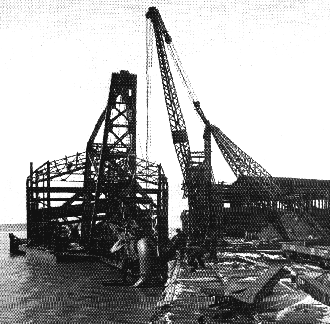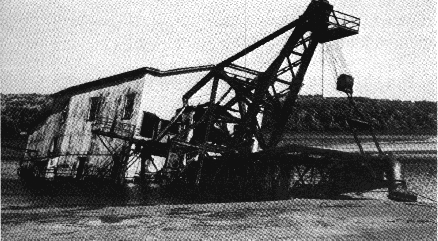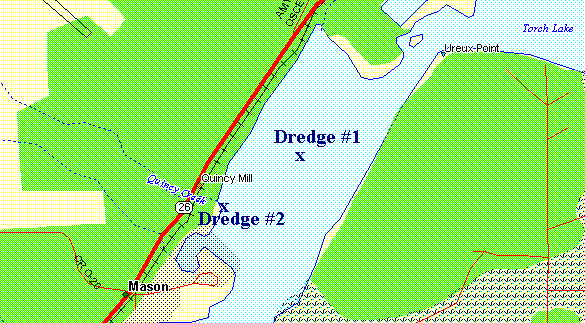
Type: Wooden hulled suction dredges Length: 70 x 30 x 5 ft., c. 200 gt. Depth: 40 ft. Location: Torch LakeDredge #1 LAT/LON: 47.09.00'/88.27.01' LORAN: 31915.8/46652.1
Dredge #2 LAT/LON: 47.08.69'/88.27.58' LORAN: 31918.9/46652.2

For almost 100 years, the copper mines of the Keweenaw extracted copper from mined rock with the use of stamp mills. The mined rock was smashed by large stamp heads and the brittle non metallic rock broke off leaving the metallic copper. The broken poor rock was ground into "stamp sand" and simply dumped into the lake. Subsequently, large fields of stamp sand now line the Keweenaw Waterway and Lake Superior. Portions of Torch Lake by Lake Linden and Hubbell were almost completely filled in. After WWII it was found that the stamp sand still contained a great deal of copper which could be extracted at a profit by regrinding it. Because of this, in 1947 the Calumet and Hecla Mining Company built a suction dredge capable of vacuuming stamp sand off the lake bottom to a depth of 110 ft. The dredge was operated by the Quincy Mining Co. and was a common sight on Torch Lake throughout the summer months, where it could be seen "mining" the discarded tailings from Torch Lake.

The dredge was usually laid up during the winter months by anchoring it out in the lake, and it carried onboard pumps to combat the slow leakage of water through its hull. Apparently, at 9:00 AM on Sunday January 15, 1956, the pumps stopped working, and before they could be restarted, the dredge plunged to the bottom, leaving only her roof exposed. Raising the dredge was thought to be uneconomical and only limited salvage was conducted. Gradually, the dredge settled into the lake bottom leaving only the peak of her roof above water.
Today, the Quincy Dredge #1 is barely visible above the surface and can be seen from Hwy. M26 by Hubbell. Her sister dredge, the Quincy Dredge #2 lies near her, up on the beach at Mason. The Dredge #1 is a truly creepy dive and offers low visibility, especially near the lake bottom. Her steel superstructure is all that remains, and it rises over 40 ft. off the lake bottom. A good deal of machinery has been left at the site, but low visibility and general creepiness hampers most exploration. Divers who want to explore the Dredge should do so in early Spring or late Fall with a good dive light. Ice diving the Dredge in the Winter may also be a good option for divers with ice diving experience.
Although not a divable wreck, the Quincy Dredge #2 is also interesting to explore and is partially submerged along the nearby shore. She sank under similar circumstances in the Winter of 1968. She had been contructed after the loss of Dredge #1 by R.C. Buck Contractors of Superior, Wisconsin using locally cut pine wood. The wood apparently was green and had problems with rotting and leakage which eventually caused the dredge to scuttle. Because copper prices were low, the Dredge #2, along with the reclaimation project was abandoned.

References: Lake Superior Shipwrecks - Wolff, Keweenaw Copper-Mines, Mills, Smelters and Communities by Larry Lankton, Keweenaw Shipwrecks by Stonehouse